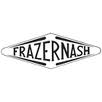A brief history of
Frazer-Nash
Introduction
The car manufacturer Frazer-Nash has made an important impact on the automotive world. In this article we will give a brief but detailed history of the Frazer-Nash marque.
We will look at the origins of Frazer-Nash looking at who, why, where and when Frazer-Nash was founded. We'll look at the design of the iconic Frazer-Nash logo and what are some the more significant Frazer-Nash models.
We'll take a glance at what racing history the Frazer-Nash has and who some of the most important people have been in the history of Frazer-Nash over the years.
Who, where, when and why was
Frazer-Nash founded?
Frazer-Nash is a renowned car manufacturer with a fascinating history that dates back to the early 20th century. The company was founded by Archibald Frazer-Nash and Henry Ronald Godfrey in 1922 in London, England. The partnership between these two talented engineers resulted in the creation of a unique brand known for its innovative engineering and exceptional performance.
The decision to establish Frazer-Nash was driven by a shared vision to build high-quality, high-performance cars that would captivate automotive enthusiasts. Both Archibald Frazer-Nash and Henry Ronald Godfrey had prior experience in the automotive industry and a passion for engineering excellence. They sought to create vehicles that combined speed, reliability, and cutting-edge technology.
At the time of its founding, Frazer-Nash focused on producing sports cars that would excel in both road and racing conditions. Their early models, such as the Frazer-Nash Super Sports and the Frazer-Nash Interceptor, gained a reputation for their remarkable performance and exceptional handling.
The company's commitment to engineering excellence and innovation set them apart in the automotive industry. They pioneered the use of advanced technologies such as chain-drive transmissions and torsion bar suspension systems, which contributed to the exceptional performance and driving dynamics of their vehicles.
Over the years, Frazer-Nash continued to evolve and adapt to changing market demands. In the 1950s, the company shifted its focus to electric vehicles, recognizing the potential of this emerging technology. They developed electric cars and hybrid systems ahead of their time, demonstrating their forward-thinking approach and commitment to environmental sustainability.
Frazer-Nash has also made significant contributions to motorsport. They actively participated in various racing events, including the prestigious 24 Hours of Le Mans, where their cars showcased their engineering prowess and performance capabilities.
Today, Frazer-Nash remains a respected name in the automotive industry, upholding their tradition of excellence and innovation. Their dedication to crafting exceptional vehicles that combine performance, technology, and sustainability has cemented their place as a distinguished car manufacturer.
How did the
Frazer-Nash logo originate?

How did the Frazer-Nash logo originate?
The logo of Frazer-Nash has evolved over time, reflecting the brand's journey and its commitment to innovation and performance. In its early years, the company's logo featured a distinctive emblem that combined the initials "FN" in an elegant and stylized manner. The interlocking letters represented the collaboration between Archibald Frazer-Nash and Henry Ronald Godfrey, the co-founders of the company.
As the brand expanded its offerings and ventured into electric vehicles, the logo underwent a transformation to reflect this new direction. The updated logo incorporated elements symbolizing electricity, such as lightning bolts or stylized electric circuits, to signify Frazer-Nash's focus on electric and hybrid technology.
Throughout its history, the Frazer-Nash logo has maintained a sense of sophistication and elegance, reflecting the brand's commitment to craftsmanship and engineering excellence. The logo designs have been characterized by clean lines, balanced proportions, and a sense of timeless appeal.
Over the years, the Frazer-Nash logo has become synonymous with the brand's core values of performance, innovation, and sustainability. It represents the brand's evolution and adaptation to changing automotive trends, from its early sports car heritage to its pioneering efforts in electric mobility.
The Frazer-Nash logo serves as a visual symbol that embodies the brand's identity and heritage. It reflects the company's dedication to pushing the boundaries of automotive engineering and creating vehicles that deliver exhilarating performance while embracing greener technologies.
What are some of the significant
Frazer-Nash models?
Frazer-Nash, renowned for its commitment to engineering excellence, has produced a range of significant models throughout its history, with a particular focus on higher performance vehicles. In the early years of the company, one of its notable models was the Frazer-Nash TT Replica. Introduced in the 1920s, this sports car was known for its lightweight construction and exceptional handling. The TT Replica featured an aerodynamic body design and a powerful engine, making it a popular choice among racing enthusiasts.
In the following decades, Frazer-Nash continued to push the boundaries of performance with models like the Frazer-Nash Le Mans Replica. Introduced in the 1930s, this sports car was designed for endurance racing, taking inspiration from the company's success in the 24 Hours of Le Mans. The Le Mans Replica featured a sleek and aerodynamic body, advanced suspension system, and a powerful engine, allowing it to compete with other renowned racing cars of the time.
As the automotive industry evolved, Frazer-Nash transitioned to electric and hybrid technologies, showcasing its commitment to sustainability without compromising on performance. One of its significant models in this era is the Frazer-Nash Metro. Introduced in the 2000s, the Metro was an all-electric city car that offered impressive acceleration and a range suitable for urban commuting. It featured advanced battery technology and regenerative braking, showcasing Frazer-Nash's expertise in electric vehicle engineering.
Another notable model in the modern era is the Frazer-Nash Namir. Unveiled in the late 2000s, the Namir was a high-performance hybrid supercar. It combined a powerful internal combustion engine with electric motors, delivering exceptional performance while reducing emissions. The Namir featured advanced aerodynamics, lightweight materials, and cutting-edge hybrid technology, exemplifying Frazer-Nash's commitment to performance and sustainability.
Throughout its history, Frazer-Nash has consistently produced models that embody the brand's core values of performance, innovation, and sustainability. From the early TT Replica to the modern electric and hybrid vehicles, each model has showcased Frazer-Nash's dedication to pushing the boundaries of automotive engineering. These significant models have solidified Frazer-Nash's reputation as a manufacturer of high-performance vehicles that embrace the latest technologies to deliver an exhilarating driving experience.

One of Frazer-Nash's Most Iconic Models
Who are some of the most important people in
Frazer-Nash's History
Behind the success and innovation of Frazer-Nash are the visionary individuals who have shaped the company throughout its history. These remarkable people have contributed their expertise, passion, and engineering prowess to establish Frazer-Nash as a leader in the automotive industry.
One of the most significant figures in Frazer-Nash's history is Archibald Frazer-Nash himself, the founder of the company. Frazer-Nash was an engineer and entrepreneur who had a deep understanding of automotive engineering and a vision for creating high-performance vehicles. His expertise and leadership were instrumental in establishing the brand and laying the foundation for its success.
Another notable person in Frazer-Nash's history is HJ "Aldy" Aldington. He joined the company in the 1930s and played a pivotal role in the development of Frazer-Nash's racing success. Aldington was a talented racing driver and an astute businessman. His racing expertise and strategic decisions helped propel Frazer-Nash to numerous victories on the track, including notable successes at events like the 24 Hours of Le Mans.
In the modern era, the leadership of the company has been in the hands of individuals like William Chia and Kamal Siddiqi. William Chia served as the Managing Director of Frazer-Nash Research Ltd, leading the company's focus on electric and hybrid technologies. His innovative thinking and commitment to sustainable mobility have been integral to the company's evolution.
Kamal Siddiqi, as the CEO of Frazer-Nash Research, has been instrumental in driving the company's strategic direction and growth. With a background in automotive engineering and a keen understanding of market trends, Siddiqi has led Frazer-Nash to embrace cutting-edge technologies and establish partnerships to further advance the brand's offerings.
These are just a few examples of the remarkable individuals who have played significant roles in the success of Frazer-Nash. Their passion, expertise, and leadership have shaped the brand's identity and contributed to its legacy of innovation and performance. Through their vision and dedication, they have propelled Frazer-Nash to new heights, solidifying its position as a respected and influential player in the automotive industry.

One of the most influential people in the history of Frazer-Nash
Frazer-Nash's Racing History

Frazer-Nash in Motorsport
Racing has been an integral part of Frazer-Nash's history, with the brand making a mark on both the road and the track. Frazer-Nash cars have showcased their exceptional performance, endurance, and engineering prowess through various racing competitions.
One of the notable achievements in Frazer-Nash's racing history is its success in endurance racing, particularly at the prestigious 24 Hours of Le Mans. The company participated in the endurance race multiple times, showcasing its commitment to performance and reliability. In 1949, a Frazer-Nash Targa Florio finished 4th overall and 1st in the 1,100cc class at the Le Mans 24 Hours race. This accomplishment solidified Frazer-Nash's reputation for producing competitive racing machines.
Frazer-Nash's success extended beyond Le Mans, with the brand's cars making impressive showings in various other racing events. The company's cars competed in events like the Mille Miglia, the Spa 24 Hours, and the Tourist Trophy, demonstrating their performance capabilities and racing pedigree.
Furthermore, Frazer-Nash's racing endeavors extended beyond traditional racing disciplines. The brand's electric vehicles have also made their mark in the emerging field of electric racing. Frazer-Nash partnered with Ecotricity, a green energy supplier, to create the "Nemesis," an all-electric sports car designed for speed and performance. The Nemesis showcased the brand's commitment to sustainable mobility and its ability to merge high-performance engineering with eco-friendly technologies.
As the automotive landscape continues to evolve, Frazer-Nash remains at the forefront of innovation in racing. The company is dedicated to exploring new avenues such as electric and hybrid technologies, pushing the boundaries of performance while embracing sustainable practices. With a rich racing heritage and a forward-thinking approach, Frazer-Nash is poised to continue making its mark on the racing world and inspiring a new generation of motorsport enthusiasts.
Summary
Frazer-Nash has a storied racing history, exemplifying its commitment to performance and pushing the limits on the track. The brand's participation in the 24 Hours of Le Mans, one of the most prestigious endurance races, highlights its racing prowess. The 1949 Le Mans race saw a Frazer-Nash Targa Florio finishing an impressive 4th overall and 1st in the 1,100cc class. This accomplishment solidified Frazer-Nash's reputation as a manufacturer of competitive racing machines.
In addition to Le Mans, Frazer-Nash cars made their presence felt in other notable racing events. The brand competed in the Mille Miglia, an iconic Italian endurance race, as well as the Spa 24 Hours and the Tourist Trophy. These events showcased the performance capabilities of Frazer-Nash cars and demonstrated their ability to compete against formidable competition.
Furthermore, Frazer-Nash ventured into the world of electric racing, highlighting its commitment to innovative technologies and sustainability. The collaboration with Ecotricity resulted in the creation of the "Nemesis," an all-electric sports car designed for speed and performance. The Nemesis showcased Frazer-Nash's ability to merge high-performance engineering with eco-friendly electric powertrains.
As the automotive industry continues to embrace electric and hybrid technologies, Frazer-Nash remains at the forefront of innovation. The brand's racing endeavors demonstrate its dedication to pushing boundaries and exploring new possibilities. With a rich racing heritage and a commitment to sustainability, Frazer-Nash continues to inspire and captivate racing enthusiasts worldwide.
View Frazer-Nash Car Specifications
More Manufacturer Histories.

























